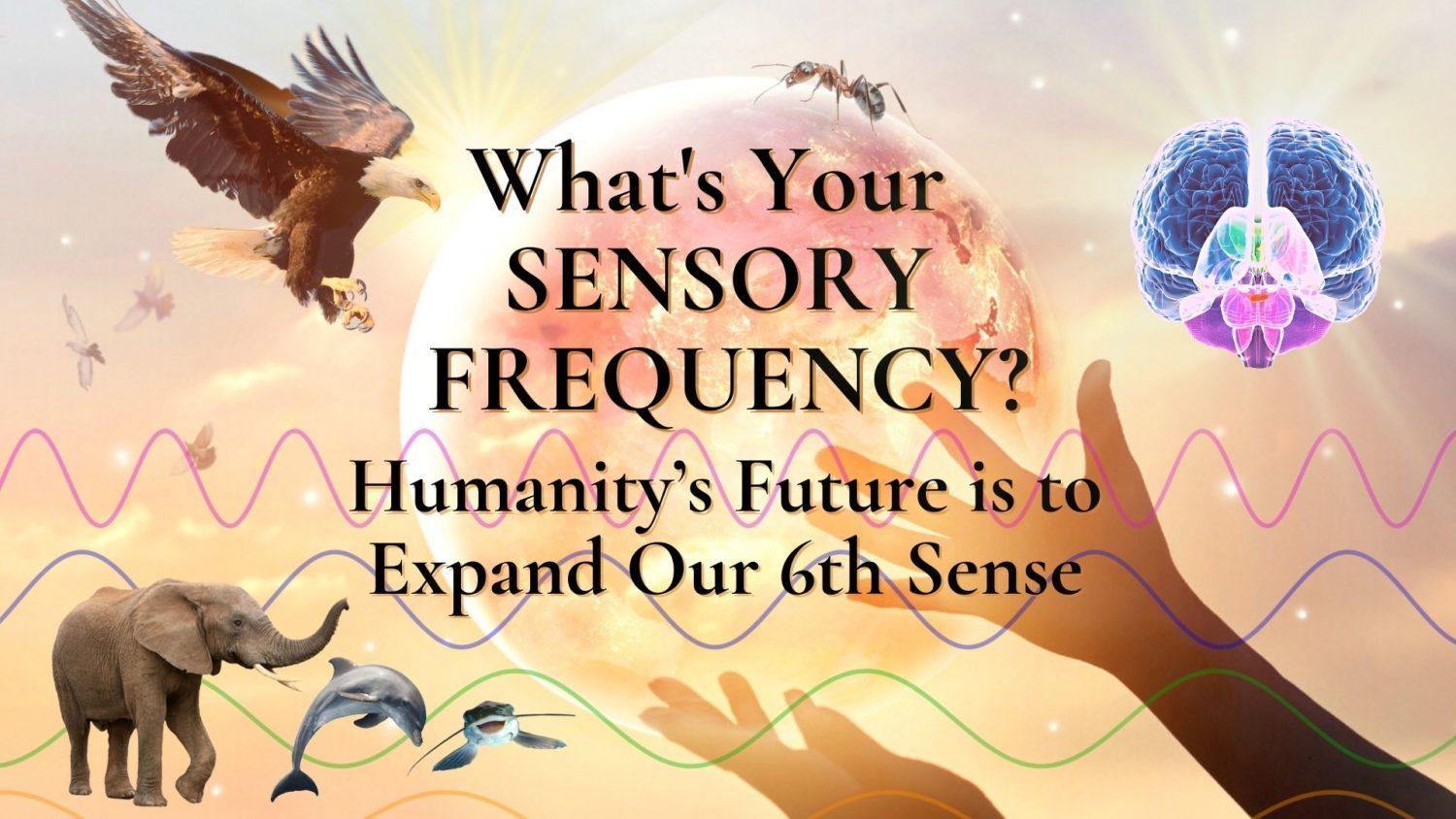 Can you feel the new vibration on the planet? Our available frequencies are expanding every day. How can we increase our perceptive range and utilize them? We live in times of increasing truth and huge disinformation. Yet what we see, hear, smell, taste, and feel are largely determined by training and our expectations. When we can’t believe what’s outside us, it’s a HINT to go inside and find answers within. Perhaps now is the time for humanity to cultivate our true inner knowing, our 6th sense.
Can you feel the new vibration on the planet? Our available frequencies are expanding every day. How can we increase our perceptive range and utilize them? We live in times of increasing truth and huge disinformation. Yet what we see, hear, smell, taste, and feel are largely determined by training and our expectations. When we can’t believe what’s outside us, it’s a HINT to go inside and find answers within. Perhaps now is the time for humanity to cultivate our true inner knowing, our 6th sense.
How attuned are you to nature? Do your physical eyes see everything that’s there to see? What if you had the eyes of an eagle? Or keen ears of a dolphin? How would that change your awareness of the world? Many animals have sensory abilities vastly beyond humans. Our five senses of sight, hearing, smell, touch, and taste can perceive only a small fraction of the total bandwidth of light, sound, and vibration that exist.
 Animals possess the same five physical senses, plus an even more important “sixth sense”, which integrates all senses into a kind of harmonious “knowing”. Animals use ALL SIX senses to fully attune to the environment. We humans may not see like an eagle or hear like a dolphin. But we have a powerful mind that can integrate the sum of frequencies we perceive into a kind of “knowing”, if we are “attuned”. Humans also have free will to choose our level of awareness, to decide which universe to inhabit. In fact, we are multi-dimensional beings. That means our awareness extends far beyond 3D physicality, outside linear time and space. Awareness is everything. In a very real sense, we perceive with our senses that which we “intend” or “wish” to see. If something is outside our mindset, we simply won’t see it. So, in fact, it is our INTENT, that CREATES our own SENSE experiences.
Animals possess the same five physical senses, plus an even more important “sixth sense”, which integrates all senses into a kind of harmonious “knowing”. Animals use ALL SIX senses to fully attune to the environment. We humans may not see like an eagle or hear like a dolphin. But we have a powerful mind that can integrate the sum of frequencies we perceive into a kind of “knowing”, if we are “attuned”. Humans also have free will to choose our level of awareness, to decide which universe to inhabit. In fact, we are multi-dimensional beings. That means our awareness extends far beyond 3D physicality, outside linear time and space. Awareness is everything. In a very real sense, we perceive with our senses that which we “intend” or “wish” to see. If something is outside our mindset, we simply won’t see it. So, in fact, it is our INTENT, that CREATES our own SENSE experiences.
So, how can we know what’s real? Learn to be an observer. Don’t buy into the emotion of it. Maybe it’s incomplete information or an outright lie. Even with the best senses, what we see and hear are mere reflections of a huge unseen world. Our perceptions are a self-centered, fractional picture at best. We know all sensory information is ephemeral and not necessarily to be believed. We must choose our path and survive in the physical world too.
What’s your frequency level in this multi-layered world? Are you a top dweller drinking nectar of the gods? Or are you a bottom feeder living in low, murky levels? The key to our evolutionary future is to integrate ALL our senses. I believe this is an invitation to expand the 6th sense, to develop our intuitive abilities to balance and “attune” with nature.
The Buddha once said:
“Everything comes from your thoughts,
Led and controlled by the mind.
Speak or act with a calm mind
Happiness and well-being follow
Like an unwavering shadow
Wherever you go.”
The Buddha, Dhammapada #2
Executive Summary
- What Animals have the Sharpest Senses? How would you like to have the eyes of an eagle? The hearing of a dolphin? The sense of smell of an elephant, touch sense of an ant, or cosmic taste buds of a catfish? Each animal is specialized in its field to survive and thrive in a challenging environment.
- What’s the Sixth Sense? All Animals Possess it. Albert Einstein once said: “The only real valuable thing is intuition.” Our 6th sense comes from the right side of your brain. It’s a kind of integrated “knowing” that attunes to the natural world. The real answers are always on the inside. How can we quiet the mind to cultivate our 6th sense? What STOPS the sixth sense? Our selfish focus on money and power closes the mind and heart. It blocks attunement to nature and our shift into higher frequencies. The truth belongs to Source, which is the divine power of Nature.
- What are the Wave Bandwidths We Can Sense? What are light, sound, and electromagnetic frequencies? What frequencies are outside our sensory bandwidth? What other frequencies can we measure with machines? Do we have any idea what frequencies lie beyond the tiny electromagnetic spectrum we measure?
- What’s Your Emotional Frequency? What brain wavelength do you live in? What is the measurable frequency of emotions? The Hawkins scale is a useful guide to measure your alignment to your destiny. How can we develop our ability to harmonize with Earth’s natural frequencies like the Schuman Resonance?
- What is Multidimensional Awareness? Check out Carl Sagan’s amusing video that illustrates the differences between 2D, 3D, 4D, 5D. Ha Ha!
- Are You a High-functioning Sensory Being? Intelligence is real, however, it’s tricky to measure. Intelligence is more than just numbers and concepts. Maybe it’s time to redefine our historically limited view of “intelligence”. Full sensory capacity means we use all six senses. When our left-right brain hemispheres are perfectly integrated and in sync with the Earth, we become super-attuned to Nature. We can participate in higher frequencies for greater health and happiness.
- Oh dear! So Many Questions: This article started out as a funny, tongue-in-cheek view of our limited human senses. But Uh Oh! Now I see it is the tip of a vast subject far beyond my abilities. And it may take lifetimes to understand. Clearly there are earthlings in advanced science and military sharing this information. Tantalizing questions explode in my mind! Please help answer them.
1. What Animals have the Sharpest Senses?
COMPARED TO AN EAGLE, HOW ACCURATE IS YOUR VISION?
Consider for a moment how we perceive beauty with the eyes. The human eye is highly accurate, an important part of our consciousness. With over two million working parts, your eye is second only to your brain in complexity. What’s actually happening inside you when you see a beautiful sunset? Inside your brain ganglions, sophisticated interpretations direct the way you see, feel, and even your emotions. No wonder vision is an essential part of our awareness of the world.
How would feel to have the eyes of an eagle? An eagle’s eyes are so large they fill 90% of the brain. Having eyes on the lateral sides of its head gives an eagle nearly panoramic 340° field of vision all around.

How does an eagle see color? The eagle’s retina has special “foveae” for focus and color discernment, with light-perception cones so densely packed that each fovea has thousands of cones. Eagles have not one, but TWO foveae focus points in each eye, packed with roughly a million cones per millimeter each. These points allow an eagle to focus in front as well as off to the side at the same time. They use their central fovea for close inspection, and the side fovea for distance vision. This in-depth focus allows an eagles’ eyes to work much like a telephoto lens to capture images and focus each lens independently, so they can simultaneously focus on two separate objects clearly!
Eagles possess exceptional accuracy distinguishing colors, because their eyes contain both vision rods and cones. Their rods contain rhodopsin for night vision. Cones for daytime color perception are even more highly developed.
Humans are mostly “trichromats”, meaning our eyes have three cone cells, allowing us to see 1 million colors. However, eagles are “tetrachromats”, with four types of cones that can differentiate 100 million colors. A few rare humans have four cones and are considered tetrachromats. This allows the eye to perceive colors more intensely, and to distinguish exponentially more colors.

A tiny oil droplet in the eagle’s cone cell intensifies the light coming through. This is how eagles perceive colors more vibrantly than humans. Some experts say eagles see an absolutely beautiful spectrum of colors and clarity unimaginable to humans. We might compare an eagle’s eye to a computer screen with densely studded pixels giving extraordinary clarity and sharpness to each image.
Although most humans have 20/20 vision, eagles possess an astounding 20/5 vision. That means that what looks sharp and clear to me at 5 feet, an eagle can see just as clearly from 20 feet. An eagle can see a rabbit three miles away. An eagle’s ultraviolet light perception allows them to follow a tiny mouse at night from high in the sky.
Eagles have eyelids that close during sleep. They also have an inner eyelid or membrane for blinking. Every three or four seconds, the membrane slides across the eye, wiping dirt and dust from the cornea. The membrane is translucent, so the eagle can see while it is over the eye.
A majestic creature, eagles can fly up to 100 miles per hour when diving for prey, while maneuvering two powerful wings that can span eight to ten feet. But eagles may find themselves in an evolutionary corner that their eyes cannot resolve. Recently a bacterium called “eagle killer” Aetokthonos hydrillicola was found in Germany in 2014. This rare bacteria causes brain damage in eagles, so that they literally go crazy. Researchers connected it to a fresh-water plant Hydrilla that concentrates toxic bromide from lake sediment, which contains poisonous chemicals from power plants, flame retardants, fracking fluids, road salts, and herbicides.
HOW WOULD YOU LIKE TO HAVE THE SUPERIOR EARS OF A DOLPHIN?
With the largest hearing range of all animals, a dolphin’s entire world is based on sound. A dolphin is able to hear a vast range of sound frequencies from 75 to 150,000 Hz. Human hearing range is only 15 to 20,000 Hz,
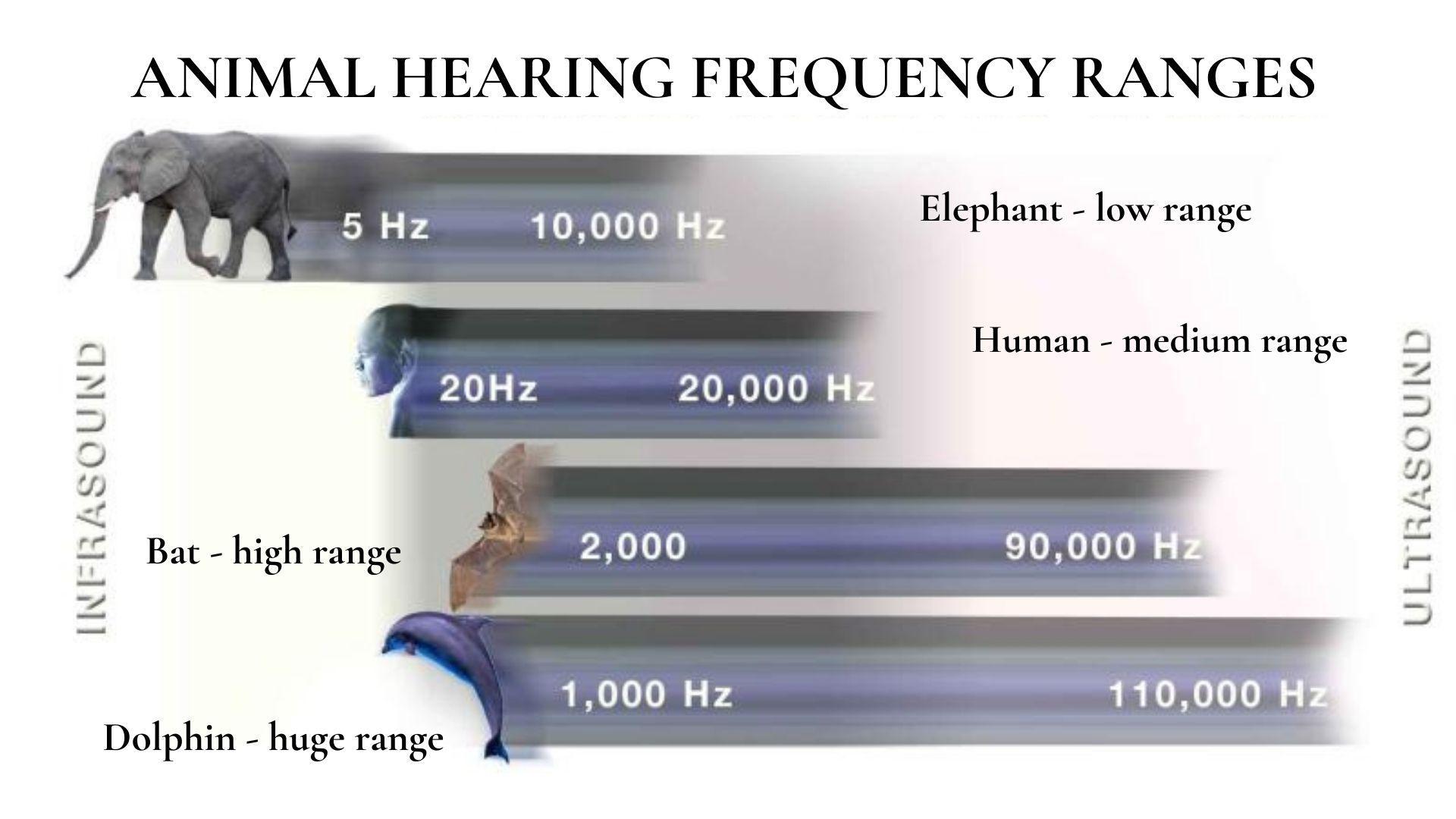
Dolphins have no external ears, just a tiny hole on each side of the head which leads to the inner ear, but this passage is filled with tissue and no longer used. Yet they hear low, medium, and high frequency tones with perfect clarity. The auditory cortex of the dolphin brain contains highly neural folds to interpret incoming sounds quickly. A dolphin’s auditory nerve is about three times the size of humans. What’s actually going on inside you when you hear a bird sing outside your window?

Dolphins make high pitched squeaks and clicks through a special organ called “the melon.” As the sounds bounce back, the type of echo allows the dolphin to “sense” what is there. The returning echo is picked up by the teeth, which amplify the vibration through fat cavities in the lower jaw, into the auditory nerve, and then to the brain for interpretation. Using “echo” to locate objects is called “echolocation”, allowing dolphins to know the shape, size, weight and density of the object and many other details. Dolphins inner ear is not attached to the skull, as ligaments hold each ear in a foam-filled cavity suspended outside the skull. A dolphin hears sounds from both ears located on separate sides. This allows a dolphin to localize an object, which is important for echolocation.
Echolocation is like sending “sonar beams” that allow a dolphin to view the internal state of another dolphin, or another living organism, to inspect something and look at its internal structure! It is said they can even gauge emotional state in that way. Some scientists report that they have been the object of sonar “inspection” of a dolphin. It feels like a gentle vibration accompanied by a dolphin whistle that starts at the top of your head, going down through the body, much like a sonar device! Because sound travels better in water than in air, this sophisticated system lets a dolphin scan 3D objects and create a 3D brain image of it based entirely on sound waves! That’s genius.
If you visit a pool of dolphins, you may hear whistling and high-pitched squeaks. Dolphins’ vocal frequencies are ten times higher than the human voice range, so you may miss the highest inaudible ultrasound frequencies. While human speech falls between 300 to 3000 Hz, dolphins talk to each other at frequencies from 3,000 to 30,000 Hz. Dolphins love to play. They talk through squeaks and whistles. And they use body language—leaping as high as 20 feet in the air, snapping their jaws, slapping their tails on the water, and even butting heads.
Dolphins have a large and highly developed brain with numerous folds, however their intelligence is vastly different from human intelligence. In fact we don’t even know how to measure it. A dolphin’s neocortex responsible for perceptions, memories, and thoughts contain far more convolutions or folds than humans. The mammal brain is divided into the left and right hemispheres.
- Left Hemisphere – Communicates using words, highly developed verbal abilities, is logical and systematic, concerned with matters as they are.
- Right Hemisphere – Communicates using images (pictures), highly developed spatial abilities, is intuitive and imaginative, concerned with emotions and feelings.
It seems that dolphins are able to communicate highly detailed information. In series of clicks, a dolphin can encode encyclopedic volumes in sound frequencies alone. Another dolphin can hear the sound and understand concepts in vibrant detail. According to a recent study, dolphins’ echolocation clicks can tell others where food is, whether a dolphin is pregnant, what mood it’s in, and what’s happening around it.
Unlike humans, dolphins have no need to manipulate their environment, but instead can use their high intellect for other purposes. Some say they specialize in transmitting the sound tones that hold the scalar-wave temples for universal structure in order. That means their sound frequencies help to maintain the frequency of Earth’s biosphere.
I’m told there’s a great deal of telepathic communication going on underwater between dolphins, whales and other species. Perhaps the large size of the dolphin’s brain is an indication of telepathy and multi-dimensional awareness. Even the military is using dolphins for remote viewing to reveal enemy information. Wow! If dolphins don’t need to perform myriad daily human tasks, I wonder what they do with all that brain power?
AN ELEPHANT’S SENSE OF SMELL IS 50 TIMES STRONGER THAN HUMANS!
Our human sense of smell starts in the nose with the olfactory bulb. This small bulb of tissue behind the nose receives stimulus from tiny food molecules or “food volatiles” floating in the air, and sends these signals into the brain. What is really going on in your brain when you smell a hot apple pie with cinnamon baking? These tiny particles stimulate the piriform cortex, amygdala, and hippocampus via two routes: front mouth route, and back nasal route. Human sense of smell and taste have separate incoming signals, which get combined in the brain. Our smell and taste senses work together to ignite memories, influence our mood, and trigger choices.
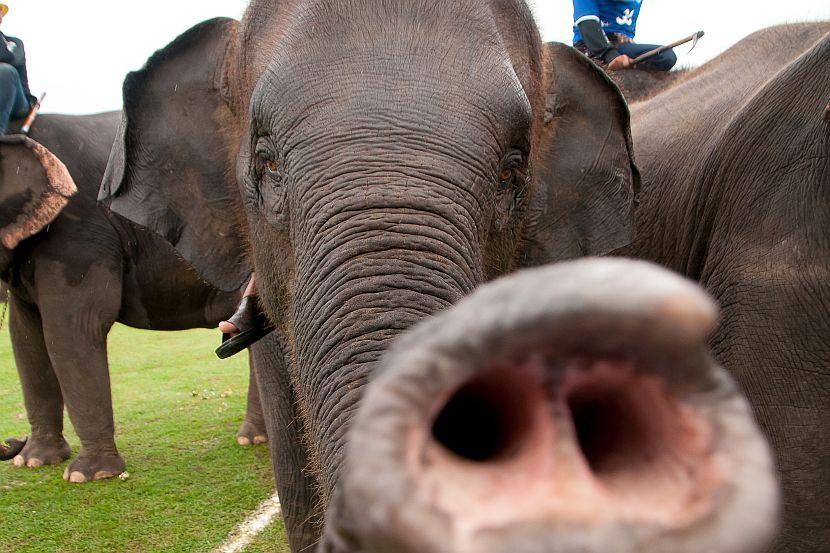 The world of an elephant is all about smell. Maybe that’s why the African Elephant has the keenest sense of smell in the world, with almost 2,000 olfactory reception genes associated. That’s far above hounds, who possess only 811 olfactory genes. A scent is drawn in through the nostrils into a series of seven olfactory organs deep in the nasal cavity.
The world of an elephant is all about smell. Maybe that’s why the African Elephant has the keenest sense of smell in the world, with almost 2,000 olfactory reception genes associated. That’s far above hounds, who possess only 811 olfactory genes. A scent is drawn in through the nostrils into a series of seven olfactory organs deep in the nasal cavity.
Elephants make up for poor eyesight with a superb sense of smell. They can smell water from an incredible 12 miles away. Female elephants ovulate for a few days every three years, and males can smell when a female is receptive. Elephants use their high sense of smell to find food, avoid danger, and can even distinguish the scent of different African tribes, in order to avoid those that hunt them. An elephant’s brain is highly complex, especially the olfactory lobe, the cerebellum, and the temporal lobe.
 Elephants also have incredible hearing. So, they communicate with each other using all kinds of frequencies, like gentle chirps, thunderous trumpets, and low-frequency infrasound humans can’t hear. All adult elephants can make infrasonic calls. These low “humming” sounds travel long distances through the air and the ground. Elephants hear these low frequencies with their enormous ears, and through their feet! Sometimes they even stand on 3 legs so they can hear better! Elephants’ hearing is so finely attuned to the earth that they can hear tectonic shifts in the Earth’s crust before tsunamis and earthquakes. They sense these low tremors even before a seismic event hits the surface.
Elephants also have incredible hearing. So, they communicate with each other using all kinds of frequencies, like gentle chirps, thunderous trumpets, and low-frequency infrasound humans can’t hear. All adult elephants can make infrasonic calls. These low “humming” sounds travel long distances through the air and the ground. Elephants hear these low frequencies with their enormous ears, and through their feet! Sometimes they even stand on 3 legs so they can hear better! Elephants’ hearing is so finely attuned to the earth that they can hear tectonic shifts in the Earth’s crust before tsunamis and earthquakes. They sense these low tremors even before a seismic event hits the surface.
Elephants possess a complex brain structure with many neural convolutions quite different from humans. I wonder, is the large and complex brain structure of elephants any indication of empathy or telepathy? They have their own language with a large vocabulary. Animal communicators attest to elephant telepathy, that they exchange thoughts and conversations of pleasure, displeasure, admonishment, and guidance. Studies show that elephants grieve their fellow elephants, make group decisions, and share cooperative tools. They console one another, and are said to have a keen sense of self.
ANTS – THE KEENEST SENSE OF TOUCH ON EARTH.
Ants may be the most successful animal on the planet, with over 12,000 species. Ants can sense the Earth’s magnetic field and use it for navigation. The largest ant colony in the world was recently discovered crossing Italy, Spain, and France over a 6,000-kilometer area with over a billion individual inhabitants. Although these ants don’t speak Italian, French, or Spanish, they can recognize each other and communicate perfectly across opposite ends of Europe. If every human on the planet stood on one side of a giant balance scale and every ant in the world got on the other, the ants would weigh more!
An ant has 250,000 brain cells, believed to be the world’s smartest insect. Ants have poor eyesight, but they make up for it with a superior sense of touch. Ants do not have ears. They “sense” vibrations by feeling them in the ground through their feet, antennae, and tiny hairs on their bodies. Each ant species relies on at least one hundred unique pheromone chemicals to guide daily activities such as finding food, building, cleaning, transporting, protecting the colony. and escaping predators. Ants live longer than any other insect–they can live up to 30 years!
Our human sense of touch is primarily on the skin surface. The skin contains a vast network of nerves, hairs, and touch receptors in a complex somatosensory system linked to the brain. What’s going on when you feel the touch of a good friend on your hand? Our brain can interpret cold, hot, smooth, rough, pressure, tickle, itch, pain, vibrations, pleasure, danger, and much more.
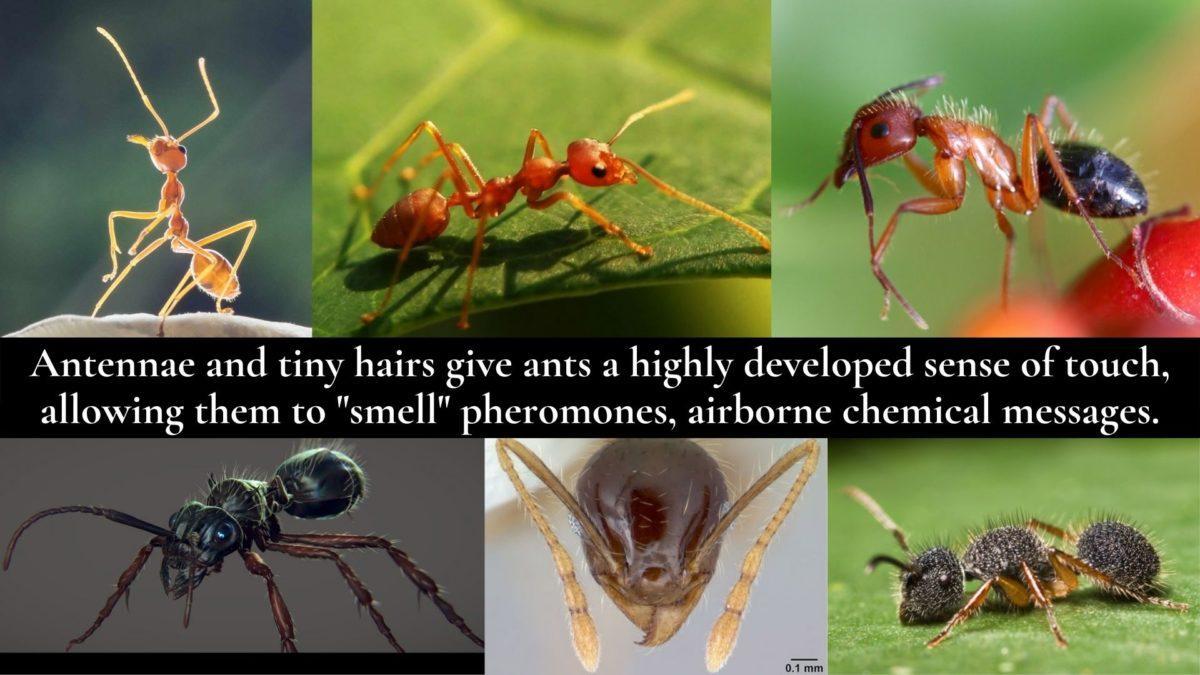
What’s a Pheromone?
Pheromones are chemical signals that tell an ant’s nervous system what to do. The scents travel slowly, last a long time, and are effective over a wide area. Vision and hearing are not needed to detect pheromones. They don’t travel in waves like sound and light, and instead go everywhere.
Pheromones are tiny floating molecules in the air that enter the sensilla, the sensory hairs of the ant. An ant is attuned to sense pheromones. The chemical information is converted to electrical energy which travels through the ant’s nervous system. A change of polarity triggers an impulse through the nervous system to the brain, informing the ant of its next move.
Ants don’t have noses or an olifactory nerve. Instead, their tiny hairs radiate vibrations to the nervous system that give an instruction. We call it our sense of “smell”. Just like a human brain can recognize the “smell” of a banana radiating tiny molecules through the air. For an ant, it’s a sense of “touch” from their antennae and hairs translated into the ability to recognize specific molecules. Amazing!
Ants produce numerous different pheromones, each with its own distinct purpose. Some pheromones signal danger to the colony, or give directions about a food source location. Other pheromones act as deterrents keeping out unwanted ants from foreign colonies or predators. Still other pheromones tell ants to come together and congregate.
Pheromones help to maintain the remarkable cohesiveness and cooperation in a colony. Specific alarm pheromones induce a quick response to tell other ants to evacuate a dangerous area such as an approaching lawnmower. If a spider approaches an ant will release alarm pheromones to alert the other ants. When an ant finds a food source, it begins to secrete a pheromone, which in her way back to the anthill leaves a clear path to the food. Pheromones also help ants to distinguish between different family members, nest mates and strangers. The queen ant also has special pheromones that let workers know her current status.
What Can Humans Learn from Ants?
Ants may win the evolutionary game due to their attunement to nature, their ability to cooperate and work together harmoniously in groups. Humans often find it challenging to fully cooperate in a social setting. Humans have an individual soul and free will connected directly to the Supreme Creator. Ants are said to have a GROUP SOUL. They are connected to Source as a group. That’s why humans can evolve as individuals. Ants evolve as a group.
Ants are not selfish and are not prone to temporary emotional madness. We humans have infinite distractions. We are mesmerized by a colorful sunset, a beautiful woman, or the promise of wealth. Our intelligence and free will are focused on responses that do not always support the wellbeing of all. We’re easily excited by sex, power, food, money, and emotions – especially fear. An ant is fearless. She doesn’t have these distractions. All her actions support the survival of the colony as a whole rather than herself.
For these reasons, ants are an example of one-pointed dedication and teamwork. They are always communicating and caring for others, assisting each other to carry out their responsibilities. Ants are team players also when it comes to sharing food. They have two stomachs, one to hold food for themselves, and one to feed other ants. If you see ants ‘kissing’ they are actually feeding another and from their 2nd stomach, which allows some ants to stay in the nest while others forage for food.
Ant colonies show us how thousands of individual creatures can respond to changes in the environment in an organized and rational way. For example, some leaf cutter ants such as Mycocepurus smithii are made up of only females, who have discovered how to reproduce without males. Instead, they are all identically cloned by the queen.
If you were to disrupt all of the pheromone trails around a colony, the ants always manage to creatively converge on a new solution, or a new structure in the nest, although it may not look the same as before the disruption. How do ants do this? A creative group mind?
CATFISH: BEST SENSE OF TASTE IN THE WORLD!
Human have about 10,000 taste buds on our tongue to savor a wide variety of flavors. When we bite into a luscious piece of chocolate cake, we might feel joy surging in our mouth and brain. However, this pales in comparison to a catfish! Catfish have 100,000 to 175,000 taste buds located all over their body. Tiny taste sensors are especially concentrated around the four pairs of whiskers and its mouth. With thousands of buds along their body, special whiskers sensors act as antennae, to allow the fish to not only taste when a prey is nearby, but also hone in on its exact location.
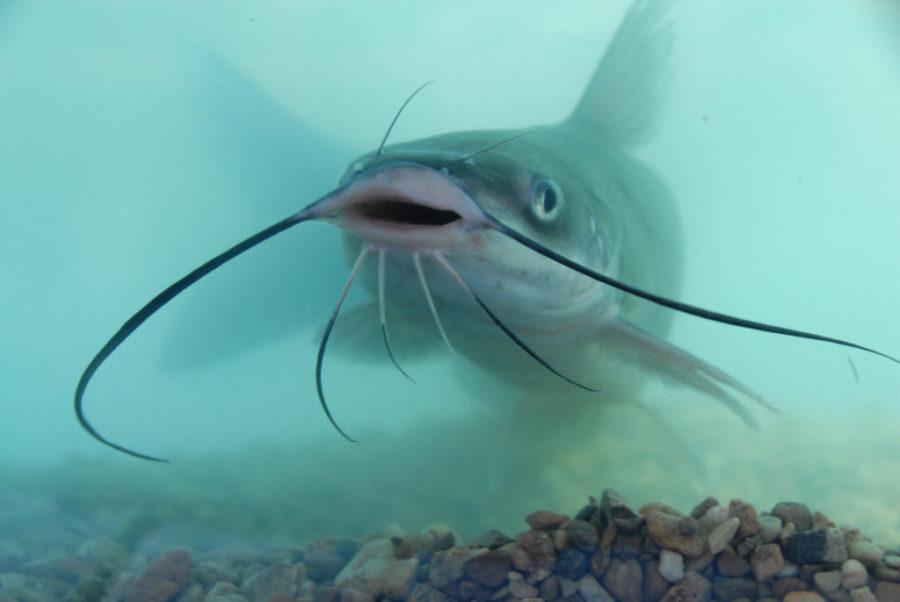
Catfish are among the most extraordinary animals on earth, with the most highly developed sense of taste of any other animal. Over 2,200 catfish species exist, representing 8% of all fish on the planet. One striking physical characteristic of catfish is the evolutionary loss of scales, and their resulting smooth skin is infused with thousands of taste sensors on the whiskers, fins, back, belly, sides and even the tail.
With a keen sense of electroreception, catfish don’t have to see, smell, or taste prey. They sense it electrically. Tiny clusters of specialized cells on the head and sides can detect electrical fields of other organisms. With electroreceptors covering its head, a catfish can find food such as insect larvae and worms deep in the mud, just by following their electric frequencies.
Catfish fossils indicate they existed some 37 million years ago in the Nile valley. Ancient Egyptians used them for their electrical stimulus to treat arthritis pain, indicated by mural paintings. Small catfish can generate a slight therapeutic electric shock. Large catfish may generate a much higher electric shock from 300 to 400 volts to stun prey and in defense. It can be uncomfortable, but is not known to be fatal to humans.
Catfish are bottom feeders, able to cope in difficult environments, and thus are often found where other fish cannot survive. Yet if catfish can taste toxins in the water, like gasoline, sunscreen, tobacco, and insect repellent; they avoid them and stop feeding. The exceptionally powerful senses of catfish enable them to thrive in muddy waters and find food in total darkness.
2. The Inner Sixth Sense? All Animals Have it
The 6th sense is a kind of integrated “knowing” that attunes to the natural world. We could call it higher intelligence beyond the five physical senses.
Albert Einstein, celebrated super-intelligent physicist of relativity once said: “The only real valuable thing is intuition.” We spend much of our lives focusing on the opposite. How valuable is that?
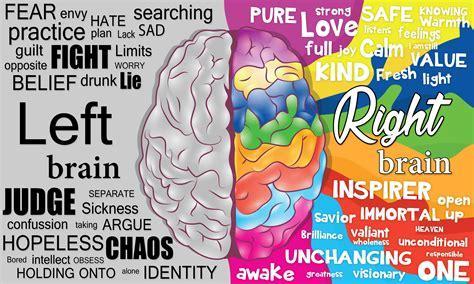
The brain is divided into two hemispheres. The left hemisphere rules fear, logic, and reason, and is easily programmed. The right hemisphere rules creativity, intuition, spirituality, and it is free. We need both sides in flexible balance. You probably drift from one side to the other many times every day.
What if a natural “knowing” emanating from inside you can answer your most pressing questions. With your brain hemispheres in balance you’d never need to ask “Siri” to help you make everyday decisions. You’d sense a question, and sort of “know” the answer. What thoughts do you emphasize in your own daily life? Maybe this time in our human history is a spiritual war pitting the left and right brain hemispheres against each other?
Animal intuition is evident all around us. This is simply their attunement to the harmony of nature. How do migratory birds sense the earth’s magnetics to find their homes thousands of miles away? How do some animals sense earthquakes before they happen? How do animals escape a tsunami before it strikes? How does your cat know when to curl up on your sore neck? How does a dolphin know your emotional state after a few squeaks? We constantly see evidence of “higher sense perception” in animals because they are intimately tuned into the natural world. They never lost that connection. Humans have allowed ourselves to become drawn into an external world of illusions. Like a mask, we suddenly believe it’s us. We focus on things outside ourselves and lose the precious soul awareness.
What STOPS the sixth sense? Our selfish focus on money and power closes the mind and heart. It blocks attunement to nature and our shift into higher frequencies. The truth belongs to Source, which is the divine power of Nature.
Animals know instinctively they are part of Nature.
By what power do they know this? Our thoughts, actions, and emotions ripple through the universal consciousness. These have a powerful effect on animals. All beings fear the separation of the body and soul, which we call “death”. If some humans are filled with fear, suddenly it can spread to all the people. Chickens are terrified. Ants and fish are upset. The honeybees and fireflies try to carry on with their jobs amid all the fear. But it is very difficult for all beings to live in an environment of violence and fear in the air. This is due to our shared connection to Nature and the 6th sense.
How to Expand the 6th Sense?
To develop your sixth sense you must feel a deep quiet inside. You will need to cultivate stillness every day. Otherwise, your experience is just a series of distractions from your path. You’ll need to know what you want and ask for it deeply. You’ll need to abandon your always looking outside for answers. You will need to quiet your mind and tune into nature. Spend an hour a day walking in the wilderness. This will awaken our inner awareness. You will need to go beyond your conditioning, your beliefs, your training, your emotions, old traumas and scars. And especially you will have to overcome your five senses. We hear and see only reflections of the larger real world. But you can always go inside and know what is true, what has real meaning.
You can raise you vibration in so many ways. When we purify the body, mind, and spirit we can see everything more clearly. That means eating healthy food and drinking plenty of clean water. It’s not easy to be balanced in this wild world, but you can do it with a bit of effort. Make sure you have a balancing exercise you can do to restore equilibrium when you hit a tough spot.
You will need to practice using the 6th sense every day – a fun game! Other keys to developing your sixth sense are meditation, going into the quiet, calming the mind, music, harmonious movement, and balancing the body to nature’s frequencies.
3. What Wave Bandwidths Can We Sense?
What are light, sound, and electromagnetic frequencies? What frequencies of light and sound do we sense, and which ones are outside our sensory bandwidth? What frequencies can we measure with machines? Do we have any idea what frequencies lie beyond the tiny electromagnetic spectrum we measure? Ha! Please tell me, I’m all ears! Below is the SOUND SPECTRUM.

Even the best eagle eyes in the world see just a tiny bandwidth of visible frequencies. The remaining vast expanse of electromagnetic waves exist outside our limited sensory bandwidth. What are light, sound, and electromagnetic frequencies? What frequencies are outside our sensory bandwidth? Why are they undetectable to us?
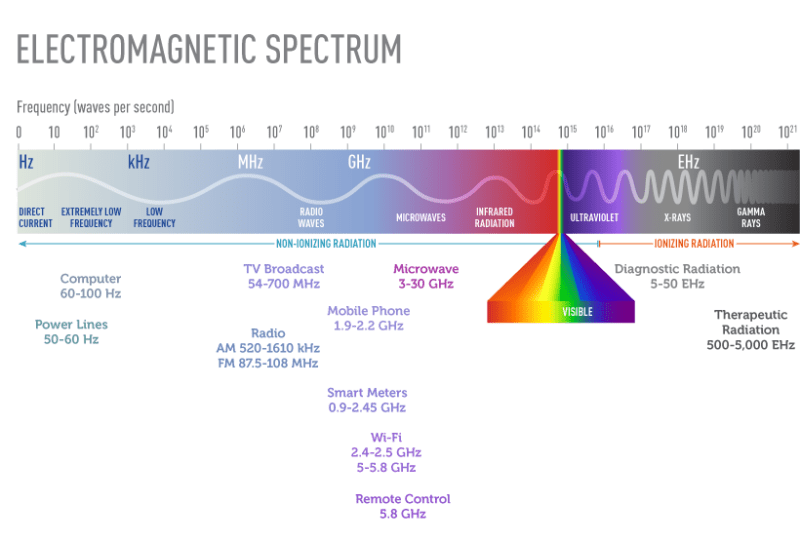
The entire electromagnetic spectrum in the image above shows that the visible spectrum of colors represents only a tiny portion. Below our visible bandwidth are the low frequency waves, radio waves, microwave, and infrared. Above our visible range are ultraviolet, X-rays, and Gamma rays.

An interesting sideline worth noting, is that the radio frequency (RF) portion of the electromagnetic spectrum is in high $ demand and competition for communication, satellites, cellular data of all varieties. This is a fast-growing area of our lives. At this time frequency bands allocated by law are between 9 kHz and 275 GHz, which means they’re designated for use by some terrestrial or space radio communication services or the radio astronomy service. See the FCC’s Table of Frequency Allocations above. These are bandwidths are used by millions of satellites circling the earth.
4. What’s Your Emotional Frequency? Brain Waves? The Schumann Resonance?
The Schumann Resonance natural rhythm is said to be the frequency of the planet Earth. The fundamental Schumann Resonance corresponds to 7.83 Hz, the high Theta of the human brainwave range. There are several Schumann Resonance frequencies. Some charts come from the Space Observation System at Tomsk Science University in Siberia.
Studies show that the Schumann resonance frequencies have beneficial effects on the human brain, nervous system, cardiovascular system, circadian bio-rhythms, immune function, and DNA. This is a relaxed, somewhat dreamy, sleepy state, also when cell regeneration and healing happens.
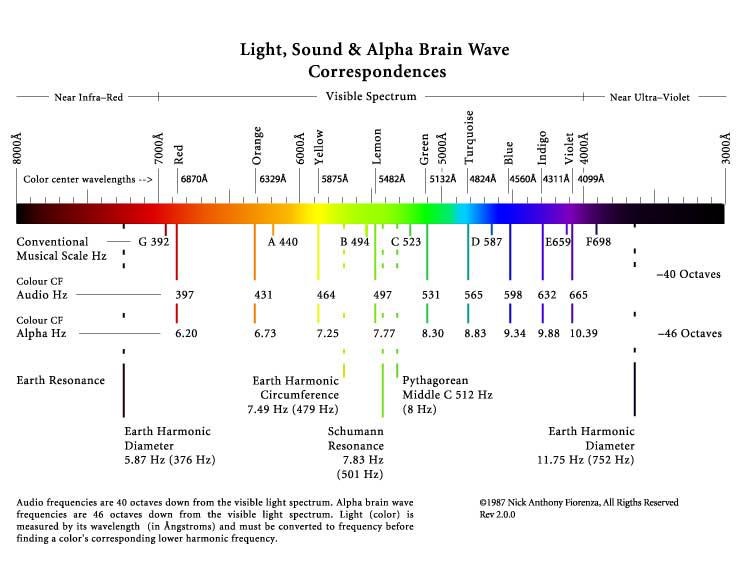
When we are attuned to the Earth’s natural frequency, healing takes place. But when our body is bombarded by other wavelengths that disrupt the natural earth’s frequency, it weakens the brain and immune system. Wifi, cell phones, and an array of electronics may contribute to disease and suffering. Some scientists believe that the spectra of brain waves and Schumann resonance can be compared. And that both are modes of electromagnetic waves. I don’t know.
Schumann Resonance ELF (Extremely Low Frequency) waves in the Earth’s magnetic field overlap with our brainwaves.
 Brain Waves can be measured using electrodes on the skull.
Brain Waves can be measured using electrodes on the skull.
- INFRA-LOW (<.5HZ)
- DELTA (.5 – 3 HZ)
- THETA (3 – 8 HZ). (Schumann 7.83)
- ALPHA (8 – 12 HZ)
- BETA (12 – 38 HZ)
- GAMMA (38 – 42 HZ)
Brain Waves and Emotions
What wavelength do you live in? Dr. David Hawkins’ “Emotional Frequency Chart” below shows the vibration levels of various emotions. We can choose to react to our sensory world out of lower levels of fear or shame, which augments our suffering. Or we can reside in higher frequencies of peace and joy that support our immune systems and raise our energy vibration. This augments the joy for us and everyone. We can train and cultivate our emotions to make us wise, powerful, unpredictable, and resilient.
Dr. Hawkins’ work revealed that our consciousness is far more than chemicals or electrical impulses in our brains. He showed that the quality of consciousness can be objectively measured using applied kinesiology.

Brain waves are not exactly electromagnetic waves. Measured brain activity is the result of individual neurons firing. The relationship between our brains and thinking is something like a transistor radio and the radio frequencies it picks up, which it then converts into audio signals that we can hear. Our brains “pick up” energies in the field of consciousness and “convert” them into what we experience as thinking. Our distinctive energetic signatures can be measured. Some of them have definite beneficial or harmful effects on our lives.
5. What is Multidimensional Awareness?
Check out Carl Sagan’s amusing video that illustrates the differences between 2D, 3D, 4D, 5D.
Cosmos – Carl Sagan – 4th Dimension – a Video
6. Are You a High-functioning Sensory Being?
Intelligence is very real, not artificial. However, it’s tricky to measure. Intelligence is more than just numbers and concepts. Maybe it’s time to redefine our historically limited view of “intelligence”. Balanced sensory capacity means we use all six senses. Our left-right brain hemispheres are perfectly integrated and in sync with the Earth, with our health.
 When we are balanced in our body, our meridians, our nervous system, then we can operate on a higher wavelength of intelligence. We can use our five physical senses and also cultivate our sixth sense of “knowing”, to effectively navigate a world of multi-dimensional complexity.
When we are balanced in our body, our meridians, our nervous system, then we can operate on a higher wavelength of intelligence. We can use our five physical senses and also cultivate our sixth sense of “knowing”, to effectively navigate a world of multi-dimensional complexity.
To discover our destiny we must learn to quiet the mind. We must develop the ability to think critically and independently. Here in the lower realms, there is much dispute, competition, and mind manipulation of the masses, just like we buy and sell radio wave frequencies. Your mind really does control the reality you experience. We see what we expect to see. We experience what we have experienced in the past.
Mindful practices give us the power to change that. In a balanced state of sensory equanimity, we can participate in higher realms of happiness, refinement, and evolution. This is what we all strive for. It is what I strive to assist my clients with. It’s what I research and write in all my books and websites.
Who Will Rule Money and Resources? And Who Will be the Slaves?
Elite decision makers are proposing total control of humans using media and Artificial intelligence.
This, my friends, is the issue on the table in the information World War III, our mind-battlefield of the 21st century. Who will control the minds of humans? And will humans accept being controlled?
Artificial intelligence and the “internet of things” have many practical applications. But these are no substitute for creativity of awakened multi-dimensional humans. Just because a few “scientists” talk about merging humans with machines in a new world order of cyber robots, does not make it a good plan.
Silicone robots and cyborg clones will never keep up with evolving humans. The new information world must be carefully managed in order to be beneficial for human society.
Just remember, robots have no thoughts of their own, no fluids, no emotions, no joy, no destiny, no spiritual power, and no soul. It’s all tricky software programming. So, cyborgs will never make it into the multi-dimensional realm as anything but slaves. The NWO dream of humans merging with AI is a joke. An evolutionary dead end. This is not a contest. It is an invitation to humans to develop your super-sensory powers and be everything you can be.

-
So Many Questions
This article started out as a funny, tongue-in-cheek view of our limited human senses. But Uh Oh! Now I see it is the tip of a vast subject far beyond my abilities – intellectual, intuitive, and spiritual. It may take me lifetimes to understand it. Clearly there are earthlings in science and the military sharing this information. Many tantalizing questions explode in my mind! Please help answer them:
- What’s the difference between light and sound waves, if any?
- What frequencies exist outside of our measurable spectrums?
- What is scalar energy? What is scalar healing?
- In higher dimensions, do sound or light frequencies have different spectrums unrelated to our 3D bandwidth?
- Is the emotions spectrum an abstract measure invented by Hawkins used only by kinesiology? Or is it part of the familiar spectrum of light that we know? And where does it fit?
- What are 2G, 3G, 4G, 5G waves used in telecommunication? Are they specific frequencies we can measure? Or are these many frequencies with similar names? Are they just thought forms used in FCC politics?
- What is Starlink? It is a quantum communications satellite system that does not use 5G 6G. How does it work? What spectrum does it use? Is it beneficial or harmful to biology? Does this quantum system allow us to expand consciousness and communicate holographic information in higher dimensions across immense distances?
- How does volume and intensity of a frequency affect its application?
- What EMF frequencies are beneficial or harmful to biological beings, at what intensity?
- Are all biolabs focused on pathogenic bugs and poisons? Do we have biolabs that study frequencies to optimize health, or to harm?
- How can we train ourselves to sense other frequencies?
- Why is nuclear energy so damaging to the body, soul, and multi-dimensional cosmos?
- Is there a DNA quality or brain type that connects to God? The “God Gene”? Is this what Bill Gates spoke to the DOD about as the VMAT2 gene of religious fundamentalism?
- He indicated a certain center of the brain lights up on hearing higher religious texts, concepts, and celestial frequencies?
- Can we use drugs to turn the spiritually illumined brain center on and off?
- Do dolphins have a concept of enlightenment? Are they perhaps already enlightened and moving freely between the embodied earthly realm and spiritual dimensions?
- With a greater understanding of frequency, it seems we could use waves to bring the entire world to enlightenment tomorrow. Or alternatively zap us into immediate evaporation. Or set us on a slow timeline to self-destruction.
- How can we beam emotional frequencies? To a crowd, to a city? To a planet? For example, can we use frequency to incite a crowd to rage and violence? To love?
- When we are angry at another person, are we effectively beaming anger frequencies at them? Can this be measured and reproduced?
- How did the Egyptian pyramids work as energy generators for health and wellbeing?
- What’s the bioscalar energy healing system? Is it within the 3D spectrum of light?
- How does Sharry Edwards sound healing work? https://soundhealthoptions.com/sharryedwards/
- How do Medbeds work?
- Does our universe have multiple dimensions? How many? Do we have 1D, 2D, 3D, 4D, 5D, 6D up to 12D? How can we perceive these higher dimensions?
- Are the dimensions like frequency bandwidths? If we perceive them, can we understand parallel realities?
- Can our Extraterrestrial brothers and sisters help us understand the multidimensional nature of the universe?
- Is there a highest God frequency or wavelength? Is it the wavelength of LOVE? Do we need to refine our spiritual capacity to feel it? Will it zap us to smithereens?
- What is God?
Well, there you have it. Please help me shed light on these questions. We already see clearly the future of humanity is taking shape. It will be amazing. What about AI? Artificial Intelligence may be useful in some ways. However, AI-human droids with the purpose to limit human evolution, will utterly fail. Humans will not allow themselves to be painted into an evolutionary corner. A few of us may accept mind-control, chipping, and DNA manipulation for a while, but over time these factions will decline. Rest assured, those humans who wish to evolve are already far beyond the net, out of the capture zone, and well on our way. Thanks for reading, and enjoy your journey!

 About
About
Sri Jana, aka Jane Barthelemy, is an intuitive medium, energy healer, craniosacral therapist, and author. A practitioner of Kundalini Buddhist meditation for over 50 years, she has an MBA and worked as CFO of Rudi’s Bakery for 10 years. Her life path includes other careers including opera primadonna in Italy and owner/designer of Marco Polo Designs Venetian glass jewelry company. Health challenges led her to teach Qigong, Taichi, and write two wellness cookbooks: “Paleo Desserts” and “Good Morning Paleo published by DaCapo Press/Hatchette Books. Her first website JanesHealthyKitchen.com recently won the 2021 Corp Today Magazine Award for “Best Healthy Food & Lifestyle Blog – North America”. Her upcoming books include: “Heal Your Past Lives”and “Buddha Speaks – Channeled Passages from the Master”. Srijana and her Bhutanese husband Lama D are faculty members of the NewEarth University. They live in Bali where they offer distant healings, classes, and retreats. FiveSeasonsMedicine.com.
Resources:
- https://www.allaboutvision.com/resources/eagle-vision/
- https://blog.hunterlab.com/blog/color-measurement/visual-assessment-human-eye-just-enough-accurate-color-measurement/
- https://interestingengineering.com/9-animals-that-can-actually-see-in-uv
- https://sites.google.com/site/eyesightofthebaldeagle/light-perception
- https://azretina.sites.arizona.edu/index.php/node/852
- http://beachbungalow8.blogspot.com/2013/01/introducing-my-super-power-tetrachromacy.html
- https://endmyopia.org/this-woman-sees-99-million-more-colors-than-you/
- https://reptile-savvy.weebly.com/vision.html
- https://www.fcc.gov/engineering-technology/policy-and-rules-division/general/radio-spectrum-allocation
- https://www.dolphins-world.com/dolphin-senses/
- https://www.dolphincommunicationproject.org/index.php/about-dcp/field-reports-new/item/94840-dolphins-have-ears-in-their-jaws
- https://omnimagazine.com/interview-john-lilly-dolphin-consciousness/
- https://www.si.edu/spotlight/buginfo/pheromones
- https://www.thoughtco.com/how-insects-smell-1968161
- https://pubmed.ncbi.nlm.nih.gov/31739452/
- https://www.brainfacts.org/Thinking-Sensing-and-Behaving/Smell/2016/Smell-An-Overview
- https://ebook.mediadata.website/pheromone-communication-in-social-insects-ants-wasps-bees-and-termites.pdf
- https://blog.acolyer.org/2015/09/22/ant-algorithms-for-discrete-optimization/
- https://www.gameandfishmag.com/editorial/fishing_catfish-fishing_gf_aa076502a/245218
- https://www.nationalgeographic.com/history/article/ancient-egypt-catfish-fossil-palaeontology-science
- https://en.wikipedia.org/wiki/Electric_catfish
- https://www.nature.com/articles/ncomms11757
- https://www.livescience.com/32970-what-animal-has-the-best-sense-of-taste.html
- https://www.thoughtco.com/olfactory-system-4066176
- https://globalelephants.org/elefact-friday-sense-of-smell/
- https://neeness.com/how-does-an-elephant-smell/
- https://en.wikipedia.org/wiki/Human_eye
- https://www.nidcd.nih.gov/health/how-do-we-hear
- https://news.yale.edu/2021/02/12/taste-and-its-two-ways-brain
- https://www.photonstimulator.com/frequency/
- https://www.hugtheuniverse.com/blog/how-to-identify-truth-in-a-confusing-world
- https://lightwarriorslegion.com/vibrational-frequency-of-thoughts-and-emotions/
- https://neuroscience.stanford.edu/events/series/ideaslab-davos-2018
- https://www.youtube.com/watch?v=vTDYtwqKBI8&t=32s – The science of how mindset transforms the human experience | Alia Crum
- https://www.hugtheuniverse.com/blog/power-vs-force-by-david-r-hawkins
- Full Wave Modeling of Brain Waves as Electromagnetic Waves, https://www.jpier.org/PIER/pier151/09.15011404.pdf
-
Schumann Resonance and Brain Waves: A Quantum Description, https://www.researchgate.net/publication/281316806_Schumann_Resonance_and_Brain_Waves_A_Quantum_Description
- https://www.eagles.org/what-we-do/educate/learn-about-eagles/bald-eagle-biology/
- https://www.studyfinds.org/dangerous-neurotoxin-bald-eagles/
- https://www.safari-center.com/elephants-intelligence-and-its-big-brains/
- https://noc.galacticage.org/Schumann-Resonance/
- https://www.thehumananimalconnection.org/post/the-elephant-whisperer-lawrence-anthony
- https://www.elephantvoices.org/elephant-communication/why-how-and-what-elephants-communicate.html
- https://blogs.scientificamerican.com/brainwaves/searching-for-the-elephants-genius-inside-the-largest-brain-on-land/
- https://www.healingsounds.com/dolphin-sounds-and-telepathy/
- https://plunketts.net/blog/20-weirdest-wildest-ant-facts
- https://sites.google.com/site/appliedbiophysicsresearch/sound/conversion-frequency-f-to-wavelength-l-and-wavelength-to-frequency


